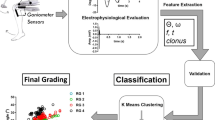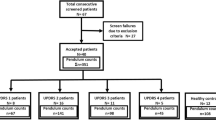Summary
Tendon reflexes were examined in 119 patients with idiopathic parkinsonism (IP) and 40 spouse controls to estimate the type and frequency of any alterations in the reflexes. Forty one of 119 patients and 2 of 40 controls had reflex ratings of 3+ at two or more sites (p<0.001). There was no correlation of reflex score with the severity of disease or with the cardinal signs of IP. In 21 patients with asymmetric tendon jerks the side with the more active reflexes correlated with the side with greater parkinsonian signs. We conclude that an increase in tendon jerks is a feature of IP. The pathophysiology of this change in reflexes should be investigated further to establish if it is a heretofore overlooked manifestation of basal ganglia dysfunction or a link with other neurodegenerative diseases.
Similar content being viewed by others
References
Adams RD, Victor M (1977) Principles of neurology. McGraw-Hill, New York, p 829
Angel RW, Hofmann WW (1963) The H reflex in normal, spastic, and rigid subjects. Arch Neurol 8: 591–596
Berardelli A, Sabra AF, Hallett M (1983) Physiological mechanisms of rigidity in Parkinson's disease. J Neurol Neurosurg Psychiatry 46: 45–53
Berardelli A, Sabra AF, Hallett M, Berenberg W, Simon SR (1983) Stretch reflexes of triceps surae in patients with upper motor neuron syndromes. J Neurol Neurosurg Psychiatry 46: 54–60
Bjorklund A, Skagerberg G (1979) Evidence for a major spinal cord projection from the diencephalan A 11 dopamine cell group in the rat using transmitter-specific fluorescent retrograde tracing. Brain Res 177: 170–175
Brain WR (1933) Diseases of the nervous system. Oxford University Press, London, p 449
Burke D, Gandevia SC, McKeon B (1983) The afferent volleys responsible for spinal proprioceptive reflexes in man. J Physiol 339: 535–552
Burke D, Hagarth K-E, Wallin BG (1977) Reflex mechanisms in parkinsonian rigidity. Scand J Rehab Med 9: 15–23
Calne DB, McGeer E, Eisen A, Spencer PS (1986) Alzheimer's disease, Parkinson's disease, and motoneurone disease: abiotropic interaction between ageing and environment? Lancet ii: 1067–1070
Delwaide PJ (1985) Are there modifications in spinal cord functions of parkinsonian patients? In: Delwaide PJ, Agnoli E (eds) Clinical neurophysiology in parkinsonism. Elsevier, Amsterdam, pp 19–32
Denny-Brown D (1968) Clinical symptomatology of diseases of the basal ganglia. In: Vinken, Bruyn (eds) Handbook of clinical neurology, vol 6. Diseases of the basal ganglia. North-Holland, Amsterdam, pp 133–137
Fahn S, Elton RL, and the UPDRS Development Committee (1987) Unified Parkinson disease rating scale. In: Fahn S, Marsden CD, Calne D, Goldstein M (eds) Recent developments in Parkinson's disease, vol 2. Macmillan, Floral Park, pp 293–304
Lee RG, Tatton WG (1975) Motor responses to sudden limb displacements in primates with specific CNS lesions and human patients with motor system disorders. Can J Neurol Sci 2: 285–293
McLellan DL (1973) Dynamic spindle reflexes and the rigidity of Parkinsonism. J Neurol Neurosurg Psychiatry 36: 342–349
Olsen PZ, Diamantopoulos E (1967) Excitability of spinal motor neurones in normal subjects and patients with spasiticity, Parkinsonian rigidity, and cerebellar hypotonia. J Neurol Neurosurg Psychiatry 30: 325–331
Rothwell JC, Obeso JA, Traub MM, Marsden CD (1983) The behaviour of the longlatency stretch reflex in patients with Parkinson's disease. J Neurol Neurosurg Psychiatry 46: 35–44
Scholz E, Diener HC, Noth J, Friedemann H, Dichgans J, Bacher M (1987) Medium and long latency EMG responses in leg muscles: Parkinson's disease. J Neurol Neurosurg Psychiatry 50: 66–70
Schwarz M, Schulte-Tamburen A, Noth J (1990) Static fusimotor activity in Parkinsonian rigidity: reconsideration of an old concept. In: Berardelli A, Benecke R, Manfredi M, Marsden CD (eds) Motor disturbances II. Academic Press, London, pp 191–201
Snow BJ, Peppard RF, Guttman M, Okada J, Martin WRW, Steele J, Eisen A, Carr G, Schoenberg B, Calne DB (1990) Pet scanning demonstrates a presynaptic dopaminergic lesion in Lytico-bodig. Arch Neurol 47: 870–874
Walshe FMR (1951) Diseases of the nervous system, 6th edn. Livingstone, Edinburgh, pp 196–197
Wilson SAK, Bruce AN (1954) Neurology, 2nd edn. Butterworth, London, pp 933–933
Author information
Authors and Affiliations
Rights and permissions
About this article
Cite this article
Hammerstad, J.P., Elliott, K., Mak, E. et al. Tendon jerks in Parkinson's disease. J Neural Transm Gen Sect 8, 123–130 (1994). https://doi.org/10.1007/BF02250923
Received:
Accepted:
Issue Date:
DOI: https://doi.org/10.1007/BF02250923




